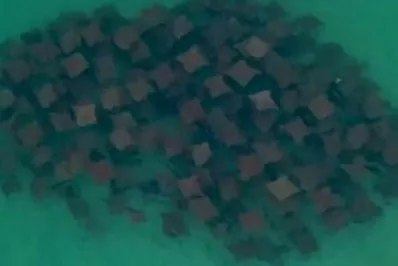Adverts
Uncovering the secrets of the ocean is an adventure that fascinates many, but few know how to deal with unexpected encounters with marine life. Among the creatures that inhabit the seas, stingrays can be both a wonder to be observed and a challenge to be faced.
Imagine yourself swimming in crystal clear waters when suddenly you find yourself surrounded by a school of stingrays. How should you react in this situation? In this essential guide, we will explore valuable tips to ensure your safety and peace of mind when encountering these majestic sea creatures. 🏝️
Adverts
In this text, you will learn foolproof techniques for dealing with situations involving stingrays, covering everything from proper body posture to the best way to interpret the behavior of these animals. Safety is a priority, and by following these guidelines, you can minimize risks and transform what could be a tense moment into an enriching experience.
Discover how to stay calm and make the most of this interaction with marine fauna, without compromising your safety or that of the animals.
Adverts
In addition, we will explore the fascinating world of stingrays, revealing interesting facts about their habits, habitats and the crucial role they play in the marine ecosystem.
Understanding these creatures not only increases your appreciation for them, but also promotes more respectful and conscious interaction. Get ready to dive headfirst into this underwater universe and emerge with practical and enriching knowledge about how to survive and admire a school of stingrays. 🌊

Understanding Stingray Behavior
Stingrays are fascinating creatures that inhabit our oceans, gliding gracefully beneath the surface of the water. To survive an encounter with a school of these majestic creatures, it is essential to understand a little about their behavior. 🌊
Stingrays are mostly peaceful creatures and avoid confrontation. They usually bury themselves in the sand to hide from predators and, contrary to popular belief, are not interested in attacking humans. However, when they feel threatened, they may use their stinger as a defense mechanism. This defensive behavior is rare and usually occurs when the ray is stepped on or feels trapped.
To avoid any misunderstandings, when you come across a school of stingrays, it is important to remain calm and observe your surroundings. Stingrays are curious animals and may approach to investigate, but in most cases, they will continue on their way without causing any problems. Learning to recognize signs of stress in stingrays, such as rapid movements or changes in direction, can be helpful in moving away safely. If you are planning a dive or tour in areas known to be home to stingrays, be sure to be aware of local customs and safety rules.
Essential Equipment and Preparation
Before diving into the waters where stingrays live, it is crucial to be well prepared. Proper equipment not only ensures your safety, but also helps protect the marine environment and the stingrays. 🏊♂️
First, invest in a good quality wetsuit. In addition to providing protection from scratches and stings from small marine animals, a well-fitting wetsuit helps maintain body temperature in colder waters. Goggles and a snorkel are essential for clear vision and easy breathing, allowing you to enjoy the underwater spectacle without worry.
Diving gloves can be helpful, but avoid touching them directly, as stingrays' skin is sensitive and can be easily damaged. Additionally, many locations prohibit the use of gloves to discourage touching the animals.
One detail that is often overlooked is the importance of not using conventional sunscreen. Opt for biodegradable products that do not harm corals and marine life. And of course, a pre-dive briefing with a local guide is always a good idea. They can provide information about sea conditions and warn of specific stingray behaviors in the area.
Safe Observation Techniques
When you encounter a school of stingrays, the temptation to get closer can be overwhelming. However, it’s vital to follow some safe observation techniques to ensure that both you and the stingrays have an enjoyable experience. 👀
First, keep a safe distance. Getting too close can make stingrays feel threatened. A good rule of thumb is to stay at least 10 feet away. This allows you to observe them without invading their personal space.
If you’re swimming or diving, avoid sudden movements. Smooth movements are more natural and less threatening. Stingrays are sensitive to vibrations in the water, so avoid kicking or stomping your feet vigorously. Floating calmly on the surface of the water is the best way to observe them.
Also, avoid surrounding a school of fish. If there are several people in the area, it is important that everyone stays on one side, giving the rays enough space to move freely. Remember that rays are part of the marine ecosystem and respecting their natural habits is essential for ethical and safe observation.
What to Do in Case of Accidental Contact
Despite all efforts to avoid contact, accidents can happen. Knowing how to react in the event of an unexpected encounter is essential to ensure your safety and that of the stingrays. 😬
If you accidentally touch or step on a stingray, stay calm. Overreacting can make the situation worse. Instead, move slowly away from the animal. In the case of a sting, which is quite rare, it is important to know that the pain can be intense, but it is usually not life-threatening.
First, get out of the water as soon as possible and seek medical attention. Washing the affected area with fresh water may help, but immersion in warm water is more effective at neutralizing the poison. Many tourist sites in diving areas have medical stations prepared to deal with this type of situation.
The best way to deal with an incident is to prevent it from happening. Always be aware of your surroundings and use the “stingray walk” when walking in shallow water – shuffling your feet rather than stepping to avoid surprising a buried stingray.
Environmental Impact and the Importance of Conservation
Human interaction with stingrays is not only a matter of personal safety, but also of environmental impact. Preserving these majestic animals is vital to the health of marine ecosystems. 🌿
Stingrays play a crucial role in maintaining the balance of ocean environments. They help control populations of small fish and crustaceans and are an essential part of the marine food chain. Unfortunately, many species of ray are threatened by overfishing, pollution and habitat destruction.
As visitors to the oceans, we have a responsibility to minimize our impact. This includes respecting local laws regarding interactions with marine life, supporting sustainable tourism practices, and participating in conservation activities whenever possible.
Avoiding waste in the environment, supporting organizations working to protect the oceans, and educating others about the importance of preserving marine life are simple steps we can take. Every action counts when it comes to protecting our precious marine ecosystems and the incredible creatures that call them home.
Interacting with Respect and Admiration
At the end of the day, encountering a school of rays is a memorable experience that should be treated with respect and admiration. The right approach turns this interaction into an opportunity to learn and connect with nature. 💙
One of the fundamental principles when interacting with marine life is mutual respect. This means not only avoiding harm to the rays, but also valuing the environment in which they live. Photographing and observing them are great ways to bring home memories, but always with caution and respect for nature.
Education is a powerful tool. Learning about stingray behavior and their role in the marine ecosystem not only enriches our experience, but also makes us more effective advocates for their protection. Sharing knowledge with other marine enthusiasts and encouraging responsible diving practices can make a significant difference.
Ultimately, when we visit the oceans, we are invited into a home that is not our own. It is up to us to ensure that when we leave, we leave only footprints in the sand and unforgettable memories. The beauty of stingrays and their habitat deserves to be respected and preserved so that future generations can continue to marvel at their grace and mystery.
Conclusion
Uncovering the secrets to surviving a school of rays is essential for any sea and nature lover. With the foolproof tips presented, it is possible to enjoy a safe and enriching experience. First of all, understanding the behavior of rays is crucial to avoid unwanted encounters. They are peaceful creatures, but they can react defensively if they feel threatened. 🌊 When approaching a school, it is vital to remain calm and observe the animals' movements, avoiding sudden movements.
Furthermore, knowledge about the marine environment and the use of appropriate equipment are essential to ensure safety. For example, protective clothing and the appropriate use of footwear can minimize risks. In addition, respecting the stingrays' space and observing them from a safe distance contributes to the preservation of the marine ecosystem.
Ultimately, these guidelines not only ensure safe interaction, but also promote greater environmental awareness. By following these tips, you not only protect yourself, but also contribute to the conservation of rays and their natural habitats. This way, each dive becomes an opportunity to learn and appreciate the rich biodiversity that the ocean offers. 🐠💧




